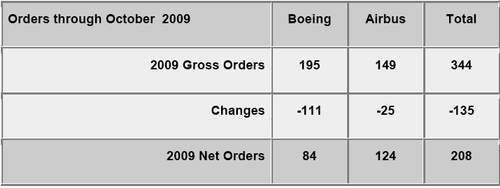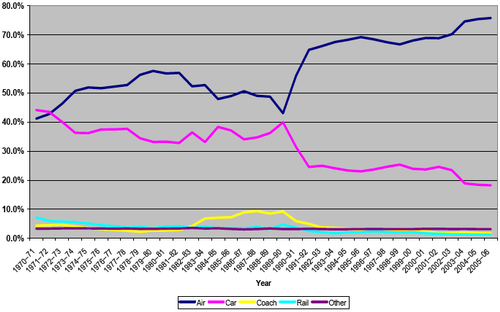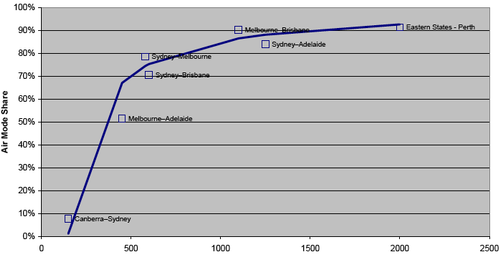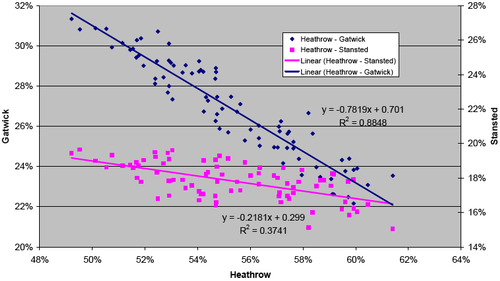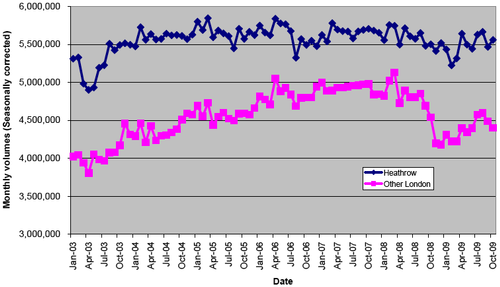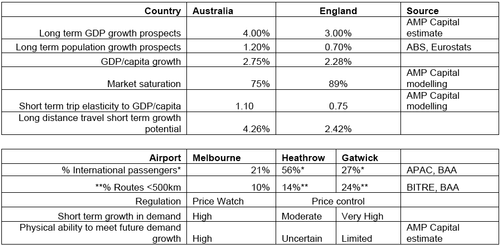AMP Capital Investors - global infrastructure airport valuations: Airports ain’t airports
Activity in the global infrastructure segment remains somewhat muted, as recovery from the global financial crisis gathers momentum. AMP Capital Investors Head of Research, Infrastructure Greg Maclean, shares his views with CAPA's Airport Investor Monthly from the latest Global Infrastructure Report, which focuses on risk factors associated with airport valuations. Given the long lead time usually associated with infrastructure projects, AMP Capital Investors is expecting the sector to lag equity markets. Maclean notes, "we feel that this is especially relevant given the forced sale by BAA of Gatwick Airport, [but] once again that the devil is in the detail".
Overview
The airline industry has always suffered periodic ups and downs, usually related to the economic cycle, but often punctuated by one-off events. The year 2009 was been no exception, with a combination of the global economic crisis and swine flu depressing demand.
Qantas CEO, Alan Joyce, commented that the year was possibly the most challenging on record, a view echoed by Richard Branson who stated, "yields are at all time low and business travel has collapsed, which suggests that there will be casualties in the next 12 months," he said. "This could see a major American carrier disappearing and other casualties following." See related report: Airline mergers gaining attention - and traction (?) in 2010
Forward aircraft orders were significantly impacted as airlines attempted to reduce outlays. Boeing, in particular, was hit by delays in its 787 programme, which have allowed a rush of cancellations.
Commercial aircraft orders 2009
Historically, the industry has weathered difficult conditions before and emerged stronger than ever. However, the future for the industry remains clouded. The potential for world-wide action on climate change is now a distinct possibility. This will adversely impact the relative cost of air travel. In Europe, Japan and now in North America and China, high-speed rail is emerging as a viable competitor to air travel, particularly for short to medium trip lengths (i.e. <3 hours). Its combination of higher on-time reliability, higher frequency, greater convenience and lower environmental impact, suggest that this mode of travel will continue to gain market share from air travel in high-density short-haul transport corridors.
What does this mean for investors in airports and other associated infrastructure? Are asset valuations valid in light of current market conditions?
The most recent significant sale was of London's Gatwick Airport by BAA to Global Infrastructure Partners, 75% owners of the small London City Airport. The sale price of GBP1.51 million, represents 97% of Gatwick's Regulated Asset Base (RAB) of GBP1.57 billion. After costs, BAA may face a write down of around 15% of the Gatwick RAB.
However, all is not as it seems. The sale of Gatwick was forced on BAA by the UK Competition Commission at the bottom of the economic cycle. That is, the conditions would seem far removed from the 'willing seller willing buyer' environment which defines fair value. It would then seem inappropriate to draw general conclusions from this one sale.
This paper considers the major risks associated with airports and will demonstrate that each facility has its own unique exposure to risks. An informed position on value can only be reached by delving into these factors.
How airports make money
Airports earn revenues essentially by levelling a range of direct and indirect tolls on passengers as they transit through the facility. These include:
- direct aviation and security charges;
- fees for parking, trolleys, taxis and transiting;
- income from property, including terminal, retail and hotel rentals.
The 'quality' of the passengers is also important and airports usually earn much higher revenues from long-haul passengers than short-haul passengers. This is a function of the more extensive services that must be provided to service long-haul passengers and their greater propensity to spend while at the airport.
While revenues are ultimately determined by passenger numbers and quality of services, airports are not as greatly exposed to the industry cycles as airlines. In a downturn, airlines are forced to discount to maintain reasonable load factors on their aircraft and this provides the airport with a partial hedge against the worst of economic conditions.
In addition, aviation, security charges and property rentals will have large fixed components. That is, the user of the facilities (the airlines) and retail tenants take the first hit in any down cycle.
Hence, airport revenues are partially hedged against bad times, and are far less impacted than airline revenues. However, this cuts both ways, and in good times, revenues are likely to grow less rapidly than airline revenues.
Airport risks and opportunities - Australian experiences
If airport revenues are ultimately determined by patronage, what determines patronage? This turns out to be:
- a function of the demand for medium and long haul travel in an economy; and
- the competitiveness of air travel against other modes of transport.
Overall demand for medium and long-haul travel in an economy is linked to gross domestic per capita (GDP/capita) and population growth. The following graph shows the relationship between demand and GDP/Capita in Australia up to 2001.
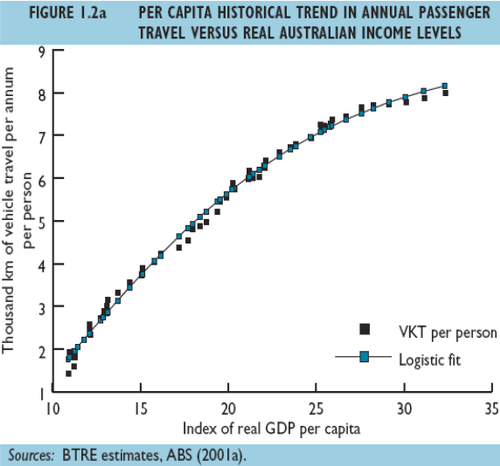
The graph illustrates that travel demand per capita growth declines as wealth per capita increases, as there is only so much time an individual can devote to travelling. That is, per capita demand tends to a saturation limit. The data shows that demand growth relative to GDP/capita can be accurately described by a logistic curve, also known as a saturation curve. Similar curves can be developed for all ec
Overall demand growth will therefore be the product of demand per capita and population growth.
The extremely high growth rates in travel achieved in some high-growth developing economies can therefore be seen as a natural consequence of high growth rates of individual wealth from a low initial base, often combined with relatively high population growth rates.
Conversely, in developed economies, where per capita wealth is higher and population growth lower, more moderate growth rates in travel demand can be expected, even if a relatively high GDP/capita growth is achieved.
A consequence of demand saturation is that the elasticity of demand to GDP/capita will decline as individual wealth increases. Failure to account for this in forecasting will lead to an overestimate of future demand growth.
This saturation curve, combined with population growth, determines the growth of gross demand for travel but does not tell us how this demand will be shared among the various modes of transport available to consumers. Market share will depend on how well air travel continues to meet consumer requirements.
Prior to the Second World War, rail was the predominant mode of inter-urban travel, but was rapidly over taken by private car travel post war. In more recent years, air travel, aided by the advent of discounted fares, has challenged private vehicles, particularly on medium and long-haul routes. The graph below shows how the mode of travel for inter-city trips >500km has changed within Australia since 1970. In a contemporary Australian context, inter-urban mode shares would seem to be battle between private-vehicle travel and air travel.
Australian Long Haul High Frequency Trips
It is interesting to see the impact of one off events. The large increase in air mode share in 1991 to 1992 follows the deregulation of the Australian airline industry in 1990. Despite a number of false starts, the threat of increased competition led to significant capacity increases and consequent discounting to maintain load factors. The next major change was the successful introduction of a dedicated low cost model by Virgin Blue in 2001 to 2002.
The figure below illustrates the market share for air travel for various inter-capital trips in Australia.
Air Mode Share 2006 - Major Trips
Greater convenience means that private cars dominate mode share on shorter routes (<200Km), as typified by the Sydney - Canberra trip. The longer the trip, however, the higher mode share achieved by air travel. For very long routes (>2,000Km) this may approach 95%.
The shape of the mode share graph is interesting. For short trips, market share changes rapidly for relatively small increments of travel distance. This suggests that trip mode choice is quite volatile in this range, or stated differently, small changes in the perceived 'value' of the travel mode can lead to large changes in relative market shares. Above about 500km, however, the graph rapidly flattens, suggesting that air travel will be relatively immune to even quite large movements in perceived value. This suggests that analysis of an airport's routes will give a useful indication of the sensitivity of an airport's patronage to competition from other modes of transport.
In Europe, the situation is somewhat different.
In addition to private cars, European high speed rail is an emerging competitor to air travel, especially on medium length stages (<500 km), or routes where a round trip can be achieved in a single day.
In France, the TGV network claims a market share of near 100% for stages less than 200km and >60% market share for stages up to 500km [source: Rail Europe]. Eurostar claims market shares in excess of 60% for travel between Paris and London and Brussels and London. Both trips are about 350km. As high-speed connections increase through France and Germany, passenger growth on Eurostar has approached 10% per annum [source: Eurostar]. In the UK, the introduction of new high(er)-speed services (200Km/Hr) on the West Coast line between London - Manchester (300km), has seen rail achieve an 88% mode share [Source:SDG]
In Europe, the attraction of high speed rail to consumers, compared with air travel includes:
- greater frequency;
- more convenient station locations;
- greater on time reliability, especially during winter; and
- competitive fares by courtesy of government subsidies.
The future prospects for high-speed rail in medium-haul corridors, with high population densities seem very good, with China, Taiwan and the US developing new networks. Compared with air travel, environmental costs are claimed to be lower, with greenhouse gas emissions per passenger about one-third of air travel. This suggests that high-speed rail will be further advantaged as society adapts to climate change.
In Australia, the case for high-speed rail is less compelling. Low population densities coupled with long stage lengths and year round clear skies, suggest that air travel will be relatively unchallenged as the primary mode for long-distance travel for the foreseeable future.
Finally, the very success of air travel can significantly impact the risk profile of individual airports. Capacity of individual airports is determined by the number of 'slots', or take offs and landings that can safely be achieved in a single day, multiplied by the carrying capacity of the aircraft. Available land, transport infrastructure and safety considerations may limit the size of the airport beyond a certain size. In such cases, it may be more practical to develop a second airport, rather than building new runways at the principal airport. In the case of very large population centres, demand can often only be met by multiple airports.
This suggests that in regions with high population densities, airports may lose the natural monopoly status that makes them prized infrastructure assets. These regions also tend to be areas where air travel is especially vulnerable to competition from high-speed rail.
London, for example, is serviced by:
- one principal airport, Heathrow;
- two major subsidiary airports, Gatwick and Stansted;
- two minor airports, Luton and London City; and
- the Eurostar high-speed rail connection to France, Belgium and Germany.
Patronage at individual airports within the London catchment depends very much on the nature of competition between the airports and their individual sensitivity to rail competition.
This has interesting implications when considering the patronage risk exposure of individual airports. On a rising travel market, growth prospects for the principal airport are largely capped, as the additional demand would be spread over the satellites.
Conversely, during the periodic down turns the industry experiences, demand can be expected to flow back to the principal airport, putting a floor under its passenger numbers, with the satellites suffering far higher volatility.
This effect can be seen from examining correlations between passenger numbers at the subject airports.
London airports market share correlations
The above graph shows total monthly passenger number correlations between Heathrow and Gatwick and Heathrow and Stansted.
Gatwick has a strong historical negative correlation with respect to Heathrow, that is, it appears to fill the role of satellite, as postulated above. Stansted is interesting in that while it too has a negative correlation with Heathrow, this is far weaker. This suggests that it has carved out more of a specialised niche than Gatwick. Stansted is the UK hub for Ryanair, the largest European airline. It could be expected, therefore, to attract a large percentage of discount travel to and from the London region, with little potential leakage to the other airports.
Passenger volumes: London airports
The effect of these mechanisms on the market share of London's airports can be seen in the above graph. Heathrow missed out on most of the growth from 2003 to early 2008, but subsequently it also saw relatively little downside from the global financial crisis.
These results may be skewed somewhat by BAA's historical control of the subject airports, but they illustrate the substantial differences in passenger volume risk of airports servicing the same market.
They may also give some insight into the regulator's decision to force BAA to sell Gatwick. UK airports, despite demonstrably being more exposed to mode share risk than their essentially unregulated Australian counterparts, have been subject to tight revenue regulation.
Possibly, this has much to do with the historical consolidation of ownership of UK Airports by BAA.
In Australia, there is no dominant airport owner and clear evidence exists of competition between airports to attract additional flights (especially international). This has resulted in a more light-handed regulatory regime, where aviation charges are under a price watch by the Australian Competition and Consumer Commission (ACCC).
Airport risk profiles: Melbourne (Australia), Heathrow and Gatwick (London, UK)
We can now put these considerations together to provide an initial high level comparison of the risk exposure of different airports. In this exercise, we compare Melbourne, Heathrow and Gatwick. This could be developed into a more quantitative assessment in a valuation exercise.
At a country level, Australia, compared with the UK, offers better growth prospects as a consequence of:
- higher population growth potential;
- higher GDP per capita growth;
- lower levels of trip demand saturation; and
- lower population densities.
At an airport level, Melbourne offers significantly better growth prospects than the London airports, as a consequence of:
- the stronger overall Australian demand growth prospects;
- limited potential competition from road transport as a consequence of its long average stage lengths;
- negligible risk from high-speed rail for the foreseeable future;
- lower levels of regulatory interference; and
- by virtue of its situation it is capable of significant further physical development with less controversy.
Heathrow scores well with its exposure to high-margin international passengers, however, despite BAA gaining government approval, it has proven very difficult to proceed with formal planning approval for a third runway in the face of determined local opposition [source: Guardian].
We expect the new owners of Gatwick to also weigh into the debate. They will probably suggest, if the 'principal - satellite' relationship with Heathrow described above, were broken and Gatwick were allowed to keep the passenger they now lose during downturns to Heathrow, then the Heathrow expansion is unnecessary.
Gatwick, now that it has been cast adrift from the BAA stable, is well positioned to retain a more equitable share of this 'floating' passenger demand, as well as grabbing the lion's share of growth in the London market. However, the new owners' ability to attract and retain new customers remains unproven. Their track record at London City is mixed, with 2009 figures 3% down on 2007, despite a record year in 2008.
High level comparison
While Gatwick has very high potential short-term demand growth, its ability to meet this demand without significant capacity expansion is unclear. In the longer-term, with a lower percentage of international long-haul flights, it also has a higher exposure to the potential erosion of market share by competition from road and high-speed rail than Heathrow.
We believe that these factors should be reflected in the relative valuations. Overall, Melbourne rates very highly in comparison, with better short and long-term growth prospects and less exposure to travel mode competition.
This note demonstrates how significant valuation differences should emerge when the particular risk factors of assets in this sector are examined in more than superficial detail.
As ever - caveat emptor.
Disclaimer: AMP Capital manages, on behalf of its clients, a 51% holding in Australia Pacific Airports Corporation (APAC), the owner and operator of Melbourne and Launceston Airports. It also manages SITES, which has a quasi - equity investment in BAA.
Acknowledgement: The author would like to thank the valuable inputs and critique of this paper from AMP Capital's London and Sydney's asset management teams.
